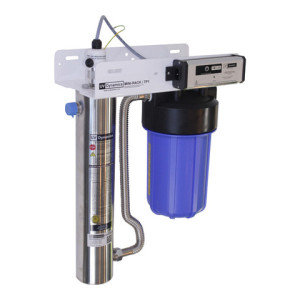UV Water Treatment Cleaner!
Ultraviolet or UV is a commonly used form of disinfection. It provides a chemical-free, low-maintenance option for treatment of private water sources. UV water treatment can be used on water from dug or drilled wells, surface water like lakes, and for harvested rainwater.
Each water sources can present unique water quality challenges which can impact the effectiveness of the UV system. For a UV water treatment system to be completely effective, the UVC light generated by the lamp needs to be able to pass through the water unimpeded so that it can inactivate any microorganisms present.
The ability of the water to transmit UVC rays is known as ultraviolet transmission (UVT). To be an effective method of disinfection, the UVT of the source water needs to be greater than 75% and some sources say 85%. The difficulty for a typical residential installation is that UVT does not directly correlate with the visual clarity of the water. For instance, a glass of distilled water will transmit UVC rays at 99 -100% but if you add a teaspoon of sugar to it and dissolve it completely, the water will look just as clear as before. But the UVT will have dropped from 100% to as little as 55%. Many water contaminants will have a similar impact.
In this region (Muskoka/Parry Sound) there are often tannins or oxidized iron in the source water making it look like weak tea. It is common for us to see UVT register between 50% and 75%. Tannins are commonly found in surface waters such lakes, rivers, and rainwater, and consist of natural organic matter that is picked up as water passes through peaty soil or decaying vegetation. You’ll likely know if tannins are present as they can give water a slight yellow tinge, tart taste, and/or earthy odour. The problem is that tannins absorb UVC light as it shines through the water. As a result, the dose of UVC light reaching the microbes is reduced and disinfection is incomplete. It’s possible to remove small amounts of tannins with a 5 micron carbon block filter prior to the UV light you need to keep in mind that these have a limited absorption capacity and will need to be changed regularly. We recommend the installation of an anion exchange unit or Tannin Filter in which the absorption media is repeatedly and automatically regenerated (much like a water softener) and will handle tannin removal much more effectively.
Common groundwater contaminants include hardness minerals (Ca2+, Mg2+) and iron. Like tannins, iron can absorb UVC light, preventing complete disinfection. However, all three minerals are troublesome in that they can, over time, deposit on or foul the quartz sleeve. This is accelerated by heat from the lamp and produces a white coating or scale and or a heavy red/brown build-up. Again, this build-up results in decreased UV dose and incomplete disinfection. Hardness and low levels of iron (<2 mg/L) are typically removed by cation exchange or water softener. At higher iron levels, removal can be achieved using oxidation and filtration. We have several different solutions for iron removal depending on the levels in the water. There are several products available that can treat for more than one issue and we would be happy to test your water and make recommendations.
Turbidity is another interfering contaminant that can be present in either ground or surface water. This material can be a fine clay or a sand. It is measured in nephelometric turbidity units (NTU). At levels above 1 NTU, suspended matter can cause two issues with the UV disinfection process. First, scattering of UV light reduces the effectiveness of the disinfection. The second issue, shadowing, is a phenomenon whereby microbes can be embedded in suspended particles and literally be shielded from the UV light as they pass through the chamber. Turbidity is easily managed with good filtration practices and we can assist you in determining the best one for your water.
Remember that to ensure a high level of microbial inactivation, always use a 5-micron filter immediately before the UV system no matter what other treatments you may have in place.
